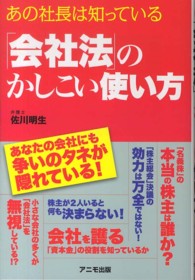基本説明
This volume offers novel insights into linguistic diversity in the domains of spatial and temporal reference, searching for uniformity amongst diversity. Conbritutions by: H. L. Chan, J. Finberg, W. Costello & Y. Shirai, Y. Nishi; et al.
Full Description
This volume offers novel insights into linguistic diversity in the domains of spatial and temporal reference, searching for uniformity amongst diversity. A number of authors discuss expression of dynamic spatial relations cross-linguistically in a vast range of typologically different languages such as Bezhta, French, Hinuq, Italian, Japanese, Polish, Serbian, and Spanish, among others. The contributions on linguistic expression of time all shed new light on pertinent questions regarding this cognitive domain, such as the hotly debated relationship between cross-linguistic differences in talking about time and universal principles of utterance interpretation, modelling temporal inference through aspectual interactions, as well as the complexity of the acquisition of tense-aspect relations in a second language.
The topic of space and time in language and culture is also represented, from a different point of view, in the sister volume Space and Time in Languages and Cultures: Language, culture, and cognition (HCP 37) which discusses spatial and temporal constructs in human language, cognition, and culture in order to come closer to a better understanding of the interaction between shared and individual characteristics of language and culture that shape the way people interact with each other and exchange information about the spatio-temporal constructs that underlie their cognitive, social, and linguistic foundations.
Contents
1. Editors and contributors; 2. Foreword: Space and time in languages, cultures, and cognition; 3. Introduction: Linguistic diversity in the spatio-temporal domain (by Filipovic, Luna); 4. I. Representing location in space and time; 5. 1. Spatial relations in Hinuq and Bezhta (by Forker, Diana); 6. 2. Pragmatically disambiguating space: Experimental and cross-linguistic evidence (by Maillat, Didier); 7. 3. The semantics of the perfect progressive in English (by Allan, Keith); 8. 4. Drowning "into" the river in North Sami: Uses of the illative (by Svenonius, Peter); 9. 5. Cross-linguistic differences in expressing time and universal principles of utterance interpretation (by Jaszczolt, Katarzyna M.); 10. 6. Modelling temporal reasoning: Aspectual interaction in determiners, adverbs, and dialogue (by Meulen, Alice G.B. ter); 11. 7. Language-specific perspectives in reference to time in the discourse of Czech, English, and Hungarian speakers (by Vanek, Norbert); 12. 8. More than "time": The grammaticalisation of the German tense system and 'frame of reference' as a crucial interface between space and time (by Zeman, Sonja); 13. II. Space and time in language acquisition; 14. 9. L2 acquisition of tense-aspect morphology: Lexical aspect, morphological regularity, and transfer (by Chan, Ho Leung); 15. 10. Motion events in Japanese and English: Does learning a second language change the way you view the world? (by Luk, Zoe Pei-sui); 16. 11. 'He walked up the pole with arms and legs': Typology in second language acquisition (by Vidakovic, Ivana); 17. 12. Caused motion events across languages and learner types: A comparison of bilingual first and adult second language acquisition (by Engemann, Helen); 18. 13. Spatial prepositions in Italian L2: Universal and language-specific principles (by Marotta, Giovanna); 19. 14. Expressing simultaneity using aspect: A comparison of oral productions in French L1, Tunisian Arabic L1, and French L2 by Tunisian learners (by Saddour, Ines); 20. III. Dynamic relations in space and time domains; 21. 15. Variation in motion events: Theory and applications (by Ibarretxe-Antunano, Iraide); 22. 16. Italian motion constructions: Different functions of 'particles' (by Mosca, Monica); 23. 17. A temporal approach to motion verbs: 'Come' and 'go' in English and East Asian languages (by Nishi, Yumiko); 24. 18. The role of grammar in the conceptualisation of 'progression': A comparative analysis of Dutch and Japanese event descriptions (by Yoshioka, Keiko); 25. 19. The locative PP motion construction in Polish: A third lexicalisation pattern? (by Lewandowski, Wojciech); 26. 20. Path salience in motion descriptions in Jaminjung (by Hoffmann, Dorothea); 27. Contents of the companion volume: Language, culture, and cognition; 28. Name index; 29. Subject index; 30. Language index








